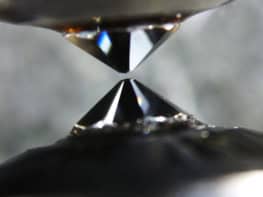
A spectrometer that directly detects the vibrational “fingerprint” of molecules offers a sensitive new way of deducing a material’s chemical make-up. The device, which was developed by researchers in Germany, Saudi Arabia and Hungary, can sense the presence of substances at much lower concentrations than is possible with state-of-the-art commercial infrared spectrometers. It can also measure the spectra of samples in water, which is impractical with conventional absorption spectrometry because water itself is such a strong absorber of infrared light. The new method is thus particularly attractive for applications in biology and medical diagnostics.
When a material is irradiated with infrared light, its constituent atoms and molecules absorb energy at frequencies that depend on their chemical structure. A few picoseconds (10-12 s) later, this absorbed energy dissipates as vibrations. Conventional infrared spectroscopy focuses on the absorption step. By analysing the light transmitted through the material, researchers determine which frequencies are absorbed, and thus which chemical species are present. The drawback is that some molecules absorb infrared light better than others, and even strongly-absorbing substances may not produce detectable dips in the transmitted light if they are only present in small amounts.
Electro-optical sampling
The new spectrometer avoids these pitfalls by focusing instead on the dissipation step. The researchers, led by Ioachim Pupeza and Marinus Huber of the Ludwig Maximilians University (LMU) and the Max Planck Institute of Quantum Optics in Garching, Germany, begin by irradiating their samples with an ultrashort pulse of infrared light. Because this initial excitation pulse lasts only a few femtoseconds (10-15 s), it delivers its energy to the sample within two oscillations of the light field. After this pulse is past, but – crucially – before the target molecules stop vibrating, the researchers apply a second ultrashort pulse of light, this time in the near-infrared region of the spectrum. This “gating” pulse carves out a slice of the electromagnetic radiation given off by the vibrating molecules – a technique known as electro-optical sampling. The researchers then analyse this vibrational signal to determine the sample’s molecular fingerprint.
A key advantage of this method, Pupeza explains, is that it separates the molecular signal from various sources of background radiation – including the initial excitation pulse. “The fact that we can carve out very brief portions of our wave means that we can exclude the excitation and only look at the molecular response,” he tells Physics World. Pupeza adds that the technique is also coherent, meaning it is only sensitive to light that is in phase with the excitation, and not to random thermal vibrations.

Infrared frequency combs detect gas leaks
The researchers tested their method, which they term field-resolved infrared spectroscopy (FRS), on several biological samples. In measurements of human blood serum, they detected changes as small as 500 ng/mL in the molecular concentration of certain chemicals – 40 times lower than is possible with a commercial infrared spectrometer. The researchers also obtained infrared spectra of live human cells in suspension and an intact willow leaf. Both materials would be hard to analyse with absorption spectroscopy because they absorb nearly all incident light.
The researchers, who report their work in Nature, hope to extend FRS in future experiments. “We would like to cover the entire infrared molecular fingerprint region to capture as many resonances as possible from complex samples,” Pupeza says. Another possibility, he adds, would be to combine FRS with a frequency comb, which could provide enough spectral resolution to analyse gaseous materials as well as solids and liquids.



